According to the expert opinions of the kids next door, Frozen is not just the best Disney movie ever, but the best movie ever ever ever.
EVER.
Which is one reason why I hesitated to include it in this Read-Watch: that expert opinion has also led the kids next door to play the English and Spanish soundtracks from Frozen at high volume on a regular basis, and, far worse, sing along with both. By the fifth rendition of “Do You Wanna Build a Snowman/Si Hacemos un Muñeco” during a Florida August, I was ready to hunt down the songwriters and bury them in snowmen myself. Plus, I had the excuse that Frozen, despite a credit that reads “inspired by” Hans Christian Anderson’s The Snow Queen, departs so far from that novella that the film is usually credited as a Disney original.
So skipping Frozen was the original plan—until, that is, I happened to reread The Snow Queen for other reasons, and realized that, in spirit, Frozen may be probably closer to its original source material than anything we’ve seen so far in this reread.
Really.
Disney animators had thought about adapting The Snow Queen as far back as 1937, when it was suggested, along with several other fairy tales, as a potential follow-up to Snow White and the Seven Dwarfs. In many ways, the story—a small girl heads off to the north to try to save her young friend, Kay, captured by the Snow Queen after his heart was pierced by a shard of evil glass—seemed perfect for a Disney adaptation. The original story even had talking animals and flowers—Disney staples—a few witches, and a prince and princess. It virtually screams “adapt this, Disney.”
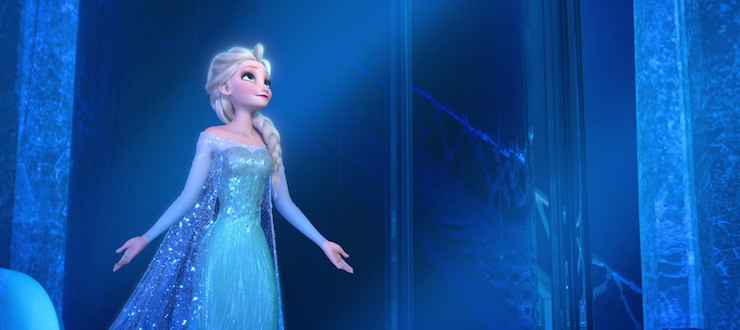
But those screams did little to help Disney adapt the story. Part of the problem—a huge problem—is that the original story arguably has too many villains: the demon who creates the original evil mirror, the witch who briefly enchants and imprisons little Gerda, the robbers, and, of course, the Snow Queen herself. But also arguably, the original story hardly has any villains at all, or at least satisfactory ones. The witch enchants Gerda out of loneliness, not malice; the robbers end up helping little Gerda; and the Snow Queen is less evil and more merely a force of nature. Indeed, at one point the Snow Queen even argues that she’s helping agriculture, and she—arguably—even helps to save Kay, by pulling him away from the dangerous sledding that almost kills him.
Granted, that’s from her viewpoint, and the text rather heavily implicates that the sledding and the snow might indeed have killed Kay, forcing Gerda to not just save Kay, but bring him back from death. But even in that reading, the Snow Queen lacks the malice Disney wanted from its villains. That left only the demon—who vanished at the beginning of the story. And although Disney had been willing to give audiences a glimpse of a demon in Fantasia, the company was not yet willing to feature a demon as the main villain of a full length animated film.
Nor was anyone at Disney particularly interested in using ice as a metaphor for reason, much less focusing on the battle between Love and Reason in the late 1930s and early 1940s. They faced other, more urgent battles. The moment slipped by. By the 1950s, Disney lacked the financial resources to animate the delicate images of ice and snow fairies as they had to such great effect in Fantasia. With no script, and no ability to animate the script, even if they had one, the original concept art was quietly filed away.

Animators took another look at The Snow Queen during the Disney Renaissance of the 1990s, but once again, nobody knew quite what to do with it. Eventually Glen Keane, assigned to take another look at it, decided to focus on the more straightforward Tangled instead. That concept art, too, was filed away, and seen by very few.
Fortunately, one of those few just happened to be John Lasseter, who had become the Chief Creative Officer at Disney Animation in 2006. As he would later tell the media, he loved the original concept art, and ordered animators to take another look at it.
Initially, that look consisted only of the filmmakers finally managing to agree on one thing: the name “Gerda” should be replaced by “Anna.” That was still more progress than anyone had made on the concept for decades, and perhaps encouraged by this one small step—or simply convinced that if he ordered it, it would come—Lasseter ordered animators to continue. By 2011, he was optimistic enough to announce that Frozen would be released in 2013, even though, at that point, the planned film had no script and no solid character designs or background work.
With a looming deadline, animators, directors, and story writers scrambled, and finally, in 2012, cracked open the concept they needed to make The Snow Queen work. They simply wouldn’t do The Snow Queen. Instead, they would change the character of the Snow Queen from villain to victim, and in her own cold way, a hero. And instead of a story focused on rescuing a boy, this would be a story about sisters.
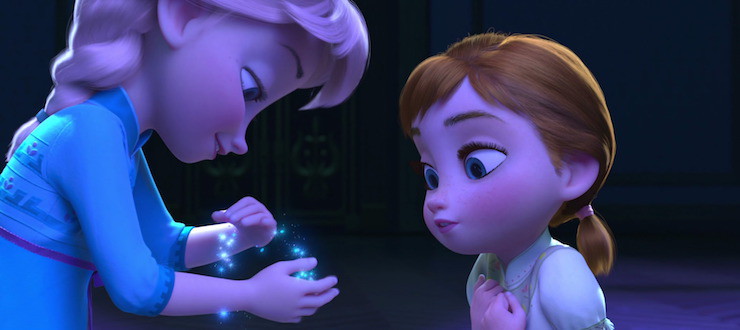
Before Frozen, very few Disney animated films had even had sisters, much less featured them. The short list included the other mermaids in The Little Mermaid, who barely speak; Alice’s older sister in Alice in Wonderland, who also barely speaks; and, more arguably, the stepsisters in Cinderella and the geese in The Aristocats. But Disney had one shining exception to this: Lilo and Stitch, which also just happened to be one of Disney’s few unquestioned post-Disney Renaissance financial successes, and which was still briskly selling merchandise at all of the theme parks and Disney stores. And the all of two Disney animated films featuring friendships between girls of similar ages—Pocahontas and The Princess and the Frog—had at least not been complete box office bombs. Plus, of course, two sisters meant two possible additions to the increasing popular Disney Princess franchise. It was enough to encourage the filmmakers to go ahead with their tale of two sisters.
In any case, the filmmakers, facing that 2013 deadline, did not have time to come up with anything else. They moved on to a new problem: how to get the new story scripted and animated in time for the immutable 2013 release. John Lasseter made one time saving decision for them: after a quick comparison of the box office takes for the hand-animated The Princess and the Frog versus the computer animated Tangled, he tossed the original plans for a lavishly hand-animated film, and instead ordered animators to work with the same process and software used for Tangled. As a nod to this decision, if you pay very very careful attention, you will see the painting that inspired the look of Tangled hanging on the walls of the Arendelle castle.
But although computer animation could be faster, it was hardly a failsafe. Tangled, for instance, had used nice warm sunny backgrounds, while Frozen used snow, something the animators had less experience with. To ensure that the snow looked like real snow, animators made trips to Colorado to look at—and stand in—real snow, and also created a new program, Matterhorn, possibly as a nod to the iconic Disneyland ride, to simulate snow effects. It was arguably used to greatest effect during what would become Frozen’s signature song, “Let It Go,” but can also be seen during the film’s climax out on the frozen lake, as the various characters struggle through wind and snow, as well as in the opening credits.
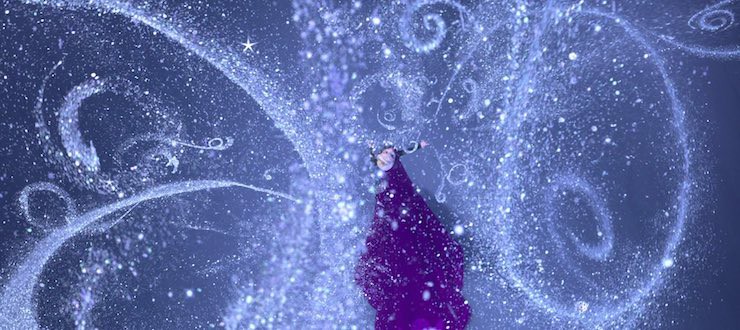
The program helped with both effects and speed. Still, the computer software could only speed things up so much, and with the deadline looming, other things—primarily the script—were rushed, which perhaps explains a few of the film’s problems. Which is to say, no, next door neighbor kids, this film is not flawless.
The biggest, perhaps, is that at times Frozen feels like two different films: the first half, a sung-through musical, and the second half, a cartoon action film. It’s not that either is bad, exactly, especially since and as superficial and sudden as the Anna and Hans romance is, it would be even more superficial and sudden without a song, making the ending even more predictable. Other songs—particularly “Do You Want to Build a Snowman”—allow Frozen to fast forward though several years of plot and character development, while still giving us glimpses of that, to the movie’s improvement. But it does create a bit of a tonal dissonance when the film suddenly flips over to more of an action film.
That dissonance is not at all helped when, in the second half, Frozen DOES suddenly remember that oh, right, it’s supposed to be a musical, and stops to have the little trolls sing about how Anna and Kristoff are both fixer-uppers, which of course means that they’re destined for each other. It’s a cute song, even if it does, perhaps, introduce a few negative things about Kristoff that the audience probably doesn’t need to know (and which never get mentioned before or after this song), and it’s useful for establishing the idea that Kristoff, not Hans, is a better match for Anna romantically, especially since at this point, Hans is still mostly acting heroic.
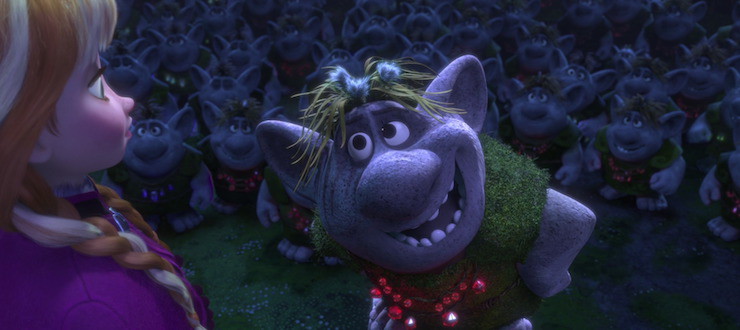
All overshadowed by one big problem: THE KINGDOM IS FREEZING TO DEATH AND ANNA IS DYING WHY ARE ANY OF YOU SINGING ABOUT THIS STUFF RIGHT NOW?
To their credit, both Anna and Kristoff make multiple attempts to stop the song, something else that should be giving the trolls pause, but it’s not enough, and Anna and Kristoff end up in a near fake marriage that mostly serves to waste time. This, I suspect, combined with the terrible advice given by the chief troll early on in the film (more on this in a bit) explains why the trolls never became huge merchandizing successes, in stark contrast to the rest of the film’s characters. When a not very bright snowman, who doesn’t even realize that fire will melt him, manages to be both more focused and wiser than a group of magical stone trolls….well.
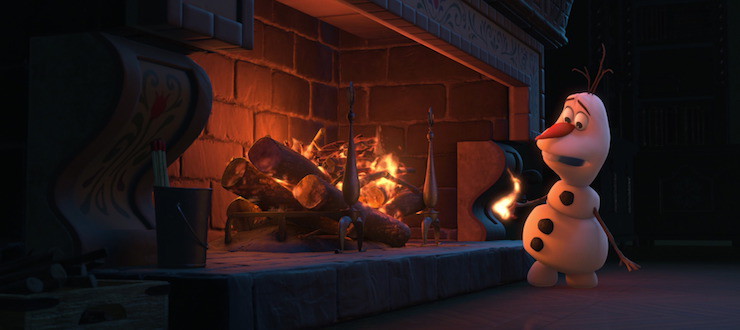
Anyway. I have more problems summoning up any gratitude for Frozen’s second overreaching problem: the many, many, many plot holes in the second half, which go well beyond poor troll timing. Most of these, I suspect, would have been ironed out, if the animators and screenwriters had been given more time. And at least one of the more glaring points—Hans announcing the death of Anna before Anna is, well, dead—can perhaps be handwaved as either a mistake on the part of Hans, or Hans’ awareness that he’s not going to be able to keep this kingdom unless he can kill the woman currently freezing it to death, and since matters keep getting worse on that front, he really doesn’t have any time to waste—and Anna’s death would somewhat justify his attempt to kill Elsa.
Other plot holes are much harder to justify. To pick just one, why, exactly, are the nobles of Arendelle suddenly cheering on Anna when she hits Hans and tosses him off the ship, like, (a) he’s still a foreign prince, Anna, and your sister is already cutting off ties with another international trading partner; do you two want to doom yourselves to permanent trading isolation, and (b) far more importantly, the last time the nobles saw Hans, they were begging him to take over the country and save it. And sure, he tried to kill Elsa—but the last time these nobles saw Elsa, she had frozen over the entire country, freezing ships in the harbor, and destroying several local businesses, and, as far as they knew, attempted to kill her sister. There’s every reason for the audience to hate Hans at this point, of course—they’ve seen him be cruel to poor Anna and leave her for dead—but no reason for the nobles to share those feelings. And, while I’m asking questions about those nobles, exactly why is anyone taking orders or suggestions from the Duke of Weselton? Sure, he’s a major trading partner, but he has even less authority than Hans does—at least Anna gave Hans some verbal authority before she took off.
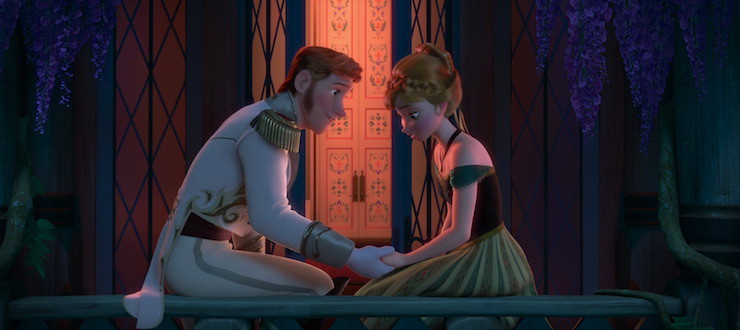
I keep mentioning Hans, in part because his flip from good guy to villain in the film’s last few minutes is another weak point. It’s not that I don’t appreciate what Disney is doing here: it’s a powerful counter to the love at first sight for previous Prince Charmings in earlier Disney films (looking mostly at you, Snow White and Cinderella, although at least Cinderella did get to spend one evening with Prince Bland, which is more than I can say for poor Snow White.) The problem is, apart from attempting to kill a woman who has, let’s remember, frozen the entire kingdom over, proposing marriage to a beautiful princess that he’s only known for about a day, and, well, ok, taking advantage of a sudden power vacuum in Arendelle, Hans honestly doesn’t seem all that bad. And if that list of things does sound awful, I should note that apart from the taking advantage of the sudden power vacuum, this is the exact same list of things done by heroes Prince Philip (who did kill a woman who sent the entire kingdom into darkness, and proposed marriage to a beautiful princess that he’d only known for a few minutes) and Prince Eric (who did help kill a woman seconds after dumping her at the altar and did propose marriage to two beautiful princesses that he’d only known for a few days) did in previous films. Sure, the audience knows that Elsa, unlike Maleficent and Ursula, is fundamentally a good person who doesn’t want to hurt anyone, but the characters only know that after shutting herself up away from people for years, Elsa turned the entire kingdom into ice.
And to give Hans some small credit, he doesn’t try to kill Elsa until nearly the end of the film—in fact, he prevents others from doing so, saving Elsa’s life. Prior to that, he seems to be, well, helpful—not exactly a quality associated with most Disney villains. He’s the first to notice that the fjord has frozen over, for instance. He opens up the castle to freezing town residents, passing out soup and blankets.
And I have to give him full credit for being the only character in the film to recognize how desperately lonely Anna is. Sure, he uses that knowledge to exploit her, but he also provides Anna with some needed emotional and pragmatic support, standing behind her when she decides to head after Elsa, over the objections of other characters. Without that support, Anna might not have been able to go. (Although maybe you should have insisted she bring more supplies along, Hans. Yay for the support, minus several points for not packing her a sandwich.) Is he doing this mostly to take over Arendelle? Maybe, but to his credit, he seems to have no thought of doing this until after Elsa has created a snow monster, and Arendelle’s nobles beg him to take over. Before that, he’s the first—and until Olaf the snowman shows up, about the only—character to show appreciation for the teenage Anna. And he’s hardly the only one to fall for Anna in the space of a few hours—Kristoff does as well.
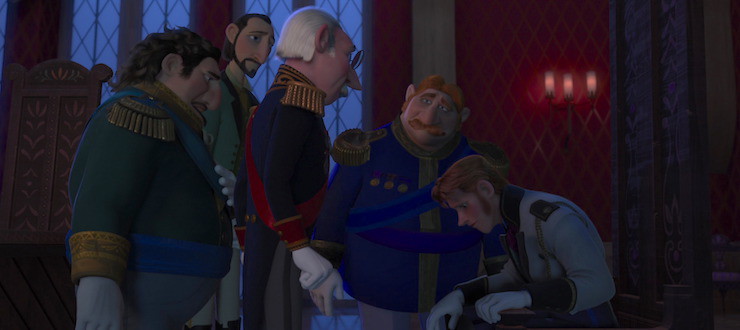
Which is why, in many ways, I find myself wishing that Frozen had taken the time to tweak Hans just a little. By all means keep him as the desperate social climber, but perhaps make his acknowledgement that he’s not in love with Anna less evil, and more regretful. Have him believe that yes, Elsa has to be killed in order to save the kingdom, instead of in order to let him take over the kingdom. Same plot, but just a tinge more complexity.
Instead, Frozen chose to give that complexity to Elsa, the innocent monster.
I say “monster” even though Elsa is beautiful, and becomes even more so in her grand number “Let It Go,” when she embraces her powers, she and those who see her powers—except for Anna and, to a lesser extent, Hans and Olaf—believe the powers, at least, are monstrous. Elsa can kill. She tries not to, but she can, and she accidentally badly injured her little sister and playmate. Accidentally injuring a younger sibling because you were goofing off and not following the rules is not that unusual (this blogger says, somewhat guiltily, while also pointing out that her brother was totally asking for it); injuring a sibling magically is something different.
And so, Elsa’s parents, with the best intentions in the world, try to isolate her. Partly to prevent her from harming others. Partly—as “Let It Go” confirms—to ensure that Elsa won’t be targeted and killed for her powers—something earlier Disney films had established as an all too probable fate, and something that does happen in Frozen, once Elsa’s powers are revealed. By keeping Elsa isolated, and by training her to hide her powers, her parents reason, she’ll be safe: no one will ever guess that she isn’t perfectly normal.
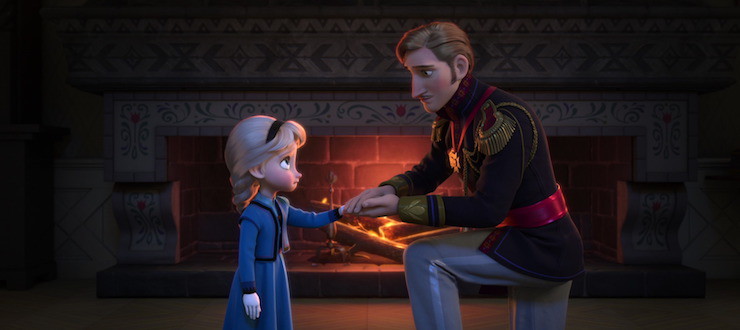
This can be, and has been, read as a metaphor for special needs children, or more precisely, what not to do with special needs children. That’s a subject far too complicated for this post, but for now, I’ll just note that this plan goes spectacularly badly. Because all the secrecy, not surprisingly, leads the countries around Arendelle to assume that Arendelle must be hiding something dreadful. It fills Elsa with self-doubt. And it leaves Anna lonely and vulnerable to anyone able to see this, and willing to say a few friendly words to her. Anna is pretty; it’s not hard for Hans to say those words. It’s a strong argument against isolating children for whatever reason.
Indeed, most of the film is an argument against listening to, or even using, reason.
It’s reasonable for Elsa’s parents to want to protect her and to ensure that she won’t accidentally harm any of Arendelle’s subjects. Kristoff and Anna reason that if an act of true love can save her, she can be saved by a kiss from Hans, the prince she believes she loves. Anna and Olaf later reason that Kristoff must be in love with Anna—otherwise, he wouldn’t be doing any of what he’s doing—and reason that a kiss from Kristoff might save her.
And yet almost all of this reasoning—except for the bit about Kristoff falling for Anna—turns out to be completely wrong.
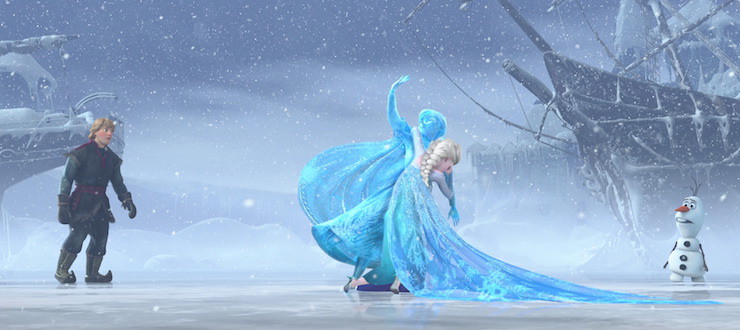
What does end up saving Elsa? Not reason, not control, but a sacrificial act of true feeling. What saves Elsa, in the end, is not reason, but love.
And that, to come back to the earlier point of this post, is why Frozen, in its heart, so closely resembles the original novella. Because above all, The Snow Queen is a novella about the dangers of reason, and the triumph of love. Reason nearly kills little Kay and Elsa and Anna and Arendelle. Love saves them.
This was hardly the first time a Disney film had used this message, of course. But Frozen added one more touch to it, something that, I think, was responsible for the film’s wild success: love also allows Elsa not just to accept, but to control her power. Frozen isn’t just a film about the conflicting power of reason and love, but also a film of self-empowerment.
We’ll just try to skip over the implication that self-empowerment means abandoning reason.
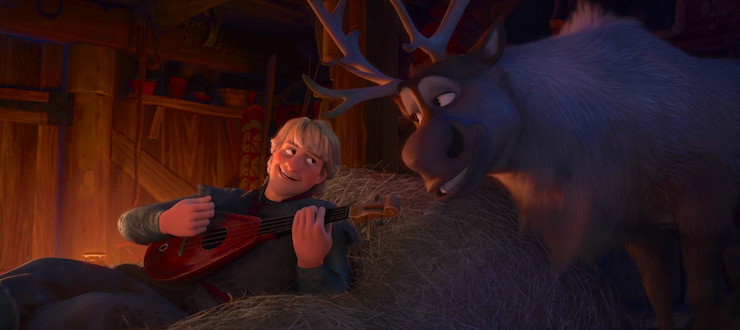
I realize I’ve barely said anything about Kristoff here, but, well, there’s not much to say: he’s cute, his best friend is a reindeer, he has the sense not to ask Anna to marry him immediately, I’m sure he’ll be a great ice transporter/princely consort, and it’ll probably be good for the kingdom to have some decidedly working class blood mingled in with the noble line. I also haven’t said much about Olaf the Snowman, though there’s quite a bit to say: designed as a toy, he is not quite as annoying as he could be, and he has one of the sweetest lines of the film, when he tells Anna that some people are worth melting for. Also, as it turns out, his plush toy version makes for a great weapon against a younger sibling.
The story development was rushed; the animation was rushed; and co-director Jennifer Lee ended up having to drag her own daughter in to voice the lines for nine year old Anna. And yet, Frozen was a wild success, becoming only the second animated film in history, after Toy Story 3, to break $1 billion at the worldwide box office. (It has since been joined in that rare category by Zootopia and Universal’s Minions.) It remains, as of this writing, the all time top grossing animated film not adjusted for inflation after only one release. Frozen also stood up well against live action features: it is, after Avatar and Titanic, the highest grossing original film of all time, and until 2015 was one of the top ten grossing films of all time, live action and animated. Part of the international success may have stemmed from Disney’s decision to have Frozen translated and dubbed into 41 languages, including two separate Spanish versions, but Frozen also enjoyed a strong domestic release.
(Adjusted for inflation, several Disney films top it, including Snow White and the Seven Dwarfs, Cinderella, The Jungle Book, and The Lion King, though those films have also benefited from having multiple releases. So far, Frozen has only had two: the initial release and a later sing along version.)
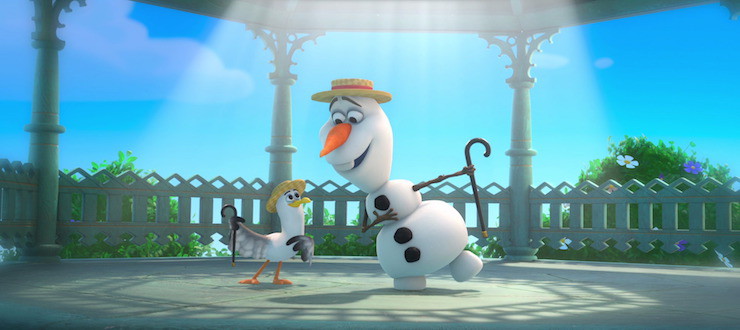
And that was just at the box office. Frozen merchandise soon became the most popular items in Disney stores. The demand caught executives, expecting Tangled sales levels, by surprise. Shoppers soon found that Frozen merchandise, and in particular Elsa merchandise, sold out. Disney ended up having to issue an official apology for underestimating demand. Disney rapidly scrapped plans for adding Elsa and Anna to the Disney Princess franchise, and instead decided to keep the two in their own, separate, and reportedly highly profitable Frozen franchise instead.
By the middle of 2014, Disney CEO Bob Iger told shareholders that Frozen was probably among their top five franchises. Lines to meet and greet Elsa and Anna grew so long that the Magic Kingdom broke down and installed a Fast Pass system to control demand—the only Fast Pass system for Meet and Greets outside of Star Wars weekends over at Hollywood Studios. The popular Maelstrom ride at Epcot was retrofitted to become a new Frozen ride—after park engineers figured out a way to squeeze the expected even longer lines into the Norway pavilion and set up a new, larger meet and greet section. (The government of Norway stopped funding the pavilion years before Frozen was released, but it’s highly possible that Disney would have decided to risk losing that funding and capitalizing on Frozen’s popularity in any case.) Disney began developing a Broadway show, and—of course—an ice skating show. Forbes has estimated that ancillary revenue from Frozen may be well over 20 times the box office take, and the film continues to enjoy steady DVD and Blu-Ray sales.
Meanwhile, Disney animators were working on their next project—something that could make use of one of Disney’s other popular franchises, Marvel Entertainment. They had found, they thought, something that could stand apart from the other Marvel films.
Next up: the last post in the Read-Watch: Big Hero 6.
Mari Ness lives in central Florida.










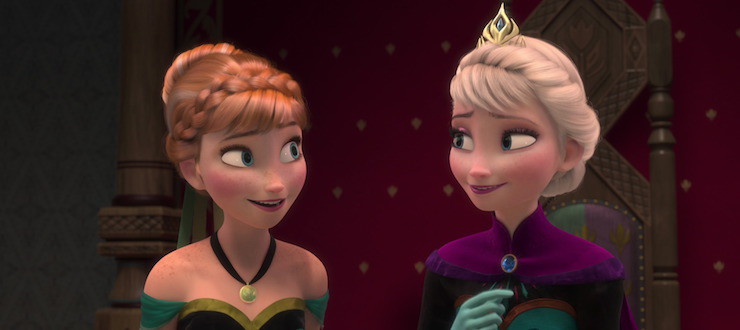
My biggest problem also concerns Hans. While I think he’s more manipulative and scheme-y even from the start–on a rewatch, it seems that when he “saved” Elsa, he was actually trying to kill her with the ice chandelier while making it look like an accident–it makes zero sense that the nobles of Arendelle would (a) not check to, you know, MAKE SURE ANNA WAS DEAD, and (b) would totally be cool with Hans taking over, no problem. I’m assuming these nobles were ruling Arendelle in the 3 years between the death of the King and Queen and Elsa’s coronation, so why are they suddenly all so gullible and willing to give up power to a total stranger? Instead of having the Duke of Weselton as a red herring villain, maybe there could have been a corrupt Arendelle council member who it turns out (gasp) actually in cahoots with Hans.
Maybe it’s just because I’m a big nerd, but I’ve always felt this movie would have been much better if it had focused on Elsa instead of Anna. As a character, Anna is just really not that interesting, and even though we spend almost the whole movie with her, she gets very little in the way of actual character development. Elsa on the other hand, is unique as far a Disney princesses go, and gets more character growth in one 3-minute song than Anna does in the whole movie.
I found Olaf more annoying than the typical comedy sidekick, but most of that comes down to the way he completely breaks the mood of the climax by explaining it. Give your audience a little credit.
I wasn’t sure if you were going to do Big Hero 6, but I’m super glad you are.
I kinda disagree with your thoughts on Hans. I saw him as immediately manipulative. Everything he does is not out of the good of his heart or worry for the refugees from the storm. Once he meets Anna, his gears start turning as he realizes she’s hopelessly naive and he can steer her toward exactly what he wants. He doesn’t “fall in love” with her – he’s seizing an opportunity to be the Prince Charming she’s obviously been dreaming about for years.
If anything, his biggest blunder is moving too fast with her – overly ambitious perhaps. If he had simply taken a more “normal” route, Elsa would have been more accepting of him, and he could have had the marriage he wanted and then “quietly disposed” of Elsa at some point. But he (and the plot) wanted to move quickly.
All the stuff after that is him putting on a show – for Anna, for the nobles, for the townspeople. It’s quite clever, but never altruistic. The only reason he tries to stop anyone from killing Elsa at any point is to keep up appearances. How “tragic” her death will be when he tries, yet fails, to save her. He’ll be loved by everyone just for his heroic attempt.
Er. Wow. There’s so much I disagree with here that I’m not sure where to start – most admittedly focusing around Hans.
For starters, the casual dismissal of his emotional manipulation and exploitation – go back and look at their love duet in hindsight, and look at how often his responses are clumsily agreeing with whatever she says, no matter how nonsensical. (The clumsiness implying a certain… lack of sincerity, shall we say?) Maybe it’s just me, but I think that kind of thing is vile – whether it’s a stepmother trying to emotionally blackmail Rapunzel or a handsome guy trying to get a princess to marry him to take power. (And his big villain speech implies that Elsa would not have been long for this world, even without the whole ‘ice princess’ thing – his attitude was that of someone watching a big obstacle remove themselves, without having to use the plans he had in mind.)
As for his being the only one to give her the emotional support to run out after Elsa – well, yeah. Because, as IIRC was also stated in his villain speech, he was expecting her to run out and get lost or killed, leaving him free to rule the kingdom. This is something we should be counting as a positive?
Finally, on the whole ’emotion vs reason’ theme – again, I think that’s largely a misreading. The entire core of Elsa’s problems is emotional – she loses control over her powers in moments of fear and panic. (Note how her original loss of control, which set off the entire plot, came when Anna outran Elsa’s ability to create snow humps for Anna to land on, and Elsa panicked.) This led to an anxiety feedback loop – control loss leads to fear of her powers, which increases her anxiety, which leads to further control loss… Reason can be used to diagnose the problem; but it’s an emotional one at heart (pun intentional), so the solution has to be emotional. (Or biochemical – I’ve watched a friend go through exactly this kind of anxiety feedback loop over his health, and what finally brought him mostly back under control was beta-blockers that calmed down his heart rate – but that’s not really a solution for Elsa.)
When she ran away from the source of her anxieties, she discovered she could have very fine control – but that came crashing back down when Anna brought back the anxieties in a way she couldn’t run away from. It wasn’t a cure, just a temporary escape that showed a cure was possible. What finally brought her a cure is actually dealing with the anxieties; is it so unreasonable that real love and support (contrasted with Hans’ fake love) was the key to doing that?
Another argument against the ’emotion over reason’ reading is Anna’s development, which is much the other way. At the start of the story, she’s overly emotional, headstrong and rushing into things without thinking. By the end, while she’s obviously fallen in love with Kristof, she’s doing the opposite – taking a measured response, calmly handling his flustered ‘I could kiss you’ babbling, and ready to let marriage wait a bit. :)
(I do agree on the trolls’ dance number; there are some good bits buried in there – I particularly like the bits about ‘don’t expect to make someone else over in your image’ and ‘people can unintentionally do bad things when they’re scared’ – but the whole thing is tonally jarring.)
I’m sad that there is only one more read/watch left. I have looked forward to these every week for a while. Can we expect sporadic updates as new movies come out? Like with the new movie Moana?
About the trolls… First, I despite the troll song, and when we watch the movie at home (which is fairly often) we skip through it. If I could figure out how to edit it out, I’d have my own director’s cut there.
Second… the advice the troll medicine man gives is not bad. Pay careful attention to what is said, and where: he tells Elsa that fear will be her enemy, and she must learn to control it. And then boom, he’s off screen, and we hear the already-set-up-as-prejudiced father dictate that Elsa will be locked up in the castle, cut off from everyone, and we see him teach her over the years to be afraid of herself.
Mph. I still struggle to grasp this film’s appeal. I might have loved it if I’d seen it in childhood, being a lifelong pushover for the “love redeems” trope and slow to discover that it was a trope and not a precious rarity. But that particular setting and story just don’t seem especially interesting in other ways. Mind you, I was too put off by the pictures of the goofy-looking snowman to take it seriously until people really started going on about it. So may be I’ll watch it someday.
This just gives me another reason to post this: Frozen – How it Should Have Ended https://www.youtube.com/watch?v=Dach1nPbsY8.
You would have thought that many rulers would have seen Elsa’s ability to wipe out an invading – or rebellious -army with a wave of her hand to be something of a plus.
@8 That How It Should Have Ended is great and really points out the problem isn’t with the trolls but the undeveloped parents.
I also think the movie lacks a good villain song in the style of Be Prepared, Gaston, or Poor Unfortunate Souls. Something like that could be hilarious and help with the later tone and clarifying Hans. As it stands now, Hans is really weir He does seem like a good guy at first and if he had just not abandoned Anna he wouldn’t have been that evil. It also makes more sense to tie yourself to a kingdom before executing your betrayal. Then at the end he just ends up in the water. That isn’t much of a punishment for someone who tried to kill the queen.
Just to tell you:
All Disney movies are translated in two spanish versions. Spanish (for Spain) and Latin (some weird mixture of mexican, colombian and a bit of central-american accent). There have been some movies, like Cars, that have also been translated to argentinian/uruguayan accent (that is veeery different from the others).
Thank you Mari, I love this articles =)
Could one reason for its popularity be for the idea that now matter how badly your parents screw you up, you can still turn out okay?
Still haven’t seen this one….
It occurred to me as I was reading that this post should have been titled “Let It Make a Lot of Dough”. A missed opportunity, that. ;-)
Perhaps… but that’s the sort of drastic measure that would quickly get you labeled as a tyrant. It’s the fantasy equivalent of the nuclear option. It would also make Elsa a prime target for assassination. I suspect that most not-actually-tyrannical rulers would decide that the cost was too high unless they were facing truly desperate circumstances.
All those nobles in the castle during the freeze are not Arendelle’s nobles, but visiting nobles from other Kingdoms (Principalities, Duchies, etc.) We see them arriving right after the “3 years later”. Plus, the accents.
Given that this is the coronation of a new Queen Regnant, the kingdom’s nobles should be attending. Since we don’t see any, this suggests that Arendelle does not have any aristocracy other than the royal family.
As to who was acting as regent until Elsa was crowned is also unclear. That it is Kai who reads Queen Elsa’s declaration of cessation of trade with Wesselton suggests perhaps he was regent, but he otherwise seems to be the castle’s head butler or something, so that seems unlikely. Perhaps Elsa herself, having already become 18 at the time of the death of her father the King, was quietly running things from behind closed doors for the next three years. Given the “closed gates” policy for the prior ten years, this would seem much different to the the people of Arendelle and other kingdoms. The three year delay until crowning could simply be an Arendelle tradition, or perhaps just Elsa putting it off again and again due to her not wanting to go out in public, until finally she couldn’t put it off any further, perhaps for legal reasons.
The mere fact of Elsa’s powers could be sufficient to guarantee peace for her kingdom for decades. Beyond simply saving lives, being able to retain a much smaller army than would otherwise be called for saves literal mountains of cash, which can be left in the pockets of the people, potentially giving them a standard of living unheard of anywhere else in the region.
Throw in the terraforming benefits and you have a resource of incalculable worth, both fiscally and morally. Imagine how much better the lives of the citizenry would be, given their geography, with Elsa openly using her powers.
Big Hero 6 may well be my favorite Disney animated feature.
I do not understand why this movie has been so wildly popular. Mari’s argument is that it is the theme of self-empowerment (possibly also the fact that love makes it possible for Elsa to control her power?). Do you all agree with that? Is that why the neighbor children assert that this is the best movie ever ever ever?
Does it all come down to the musical power, visual attractiveness and gratifying theme (self-empowerment) of “Let It Go”? Or the combination of that moment with the love-takes-away-the-power’s-danger ending? Why is this particular narrative embodiment of self-empowerment so compelling? Aren’t there lots of narratives for kids with some form of that theme? Like, all the superhero stories, and the magical coming-of-age stories? Is it that those stories don’t have great songs?
Or is part of the attraction to kids that they feel smart, because they are just old enough to recognize the tropes that are being subverted? Both the “love at first sight” trope, and the “the love that saves you is romantic love” trope.
Do kids like the fact that the salvific love is sibling love, which they themselves may experience (in all its ambivalent glory), rather than romantic love, which they have not yet experienced?
I’m just wondering, here, because I personally would rate this movie as “mildly pleasant” and I am blown away by how huge a cultural phenom it is.
Hans was definitely an opportunist, but not good at it and hadn’t (yet) actively tried killinh anyone; I think this is why dunking and banishment is his punishment from Arendelle. What will his brothers add?
Claiming Anna is dead is a plot, not a plot hole. The news can distract everyone while he sets out to make it true. If Anna was gone, Hans controls the narrative; he can claim they were betrothed or even married by a wandering Troll shaman, giving his rule a veneer of legitimacy.
Those who heard the songs over and over may be prejudiced when they see the movie, and I understand. But I saw this early with my neice, and she loves it to this day, and I liked it too. Spectacular visuals that weren’t too much (think Prequels), catchy songs but not too many, a plot that keeps moving allowing kids no time ot be bored, and no man driving the plot. This is about two sisters, first and foremost. How often does that happen?
Porphyrogenitus @17- Low tech armies are cheap, so “the people” wouldn’t get that much. Also, money in circulation would drop, constricting the money supply. Nothing is that easy :)
I did not like this one as much as Tangled, but it was a lot of fun. I liked the “Prince Charming” turning out to be a cad, a nice twist, and liked the “villain” being more of a victim of circumstances beyond her control. And that same “villain” coming to terms with her true self instead of suppressing what she was. And the love story being love between sisters rather than a romantic love story.
The only thing that I was surprised by, when I first watched it, was the lack of a big final musical number. I could understand less songs in the third reel, when the action plot took over, but not having a final song was a bit jarring. I suppose that when they put it on Broadway, which I am sure will happen at some point, they will have to come up with something.
When I saw the first trailer, which was all about the snowman, I thought it very odd, since it didn’t seem to match what they told us the movie was going to be about. But in this case, an odd marketing choice didn’t seem to make any difference in the movie’s success.
I’m totally with you re: Hans. Maybe he’s an ambitious scheming social climber who only wants power for himself… but there’s not actually any indication that he’d use that power poorly. To the contrary, even if Hans is only doing good things to keep up appearances, every action he takes is pretty much in the best interests of the people of Arendelle, something which cannot be said for Elsa and Anna. Elsa and Anna remain very self-centred or (at best) focused on each other throughout their storylines; the danger to the people of Arendelle is only of secondary concern to either of them. While this is good for the movie’s theme of sisterhood, it raises a lot of eyebrows for either Elsa or Anna’s fitness to rule the nation. While Elsa and Anna care primarily about saving and protecting each other, Hans is the only one seriously engaged with saving and protecting the people of Arendelle, even if he does so for ulterior selfish motives.
I guess what I’m saying is I’m generally speaking a Hans apologist. Dude can be as scheming and evil as he wants to be so long as he continues to take better care of the people than Anna or Elsa.
Just pointing out that originally Elsa was the Villian, but after the Let It Go song, Disney realised that it would be better to change the story to make her a good guy. They then needed a new villian, and along comes Hans, which up until he turns heel, comes across as a genuine love struck disney prince.
The movie would have worked just as well if Hans actually kissed Anna, didnt break the spell, and went to kill Elsa as the only way to save Anna – It would of made more sense too
Judging from the way the preschool/kindergarten and elementary school-age kids I know and work with talk about the movie, that’s pretty much it. The big power ballad “Let it Go” song as Elsa builds an ice palace and makes herself a slinky ice dress is just about the core of the movie. I’m not entirely sure they even notice any other part. On the up side, if you want to get a class full of five-year-olds to listen to you, start singing “Let it Go” with the wrong words. Their little heads will snap around instantly.
I was actually surprised that Anna wasn’t more popular because she’s the one who does stuff. Elsa has her one big song, but otherwise she mostly just hangs out in her ice palace. Anna has three big songs and gets to go on an adventure and saves the day. But my Frozen sticker book I use for rewards for my kindergarten choir is still full of Anna stickers (except for the ones I gave myself when I felt sorry for poor, neglected Anna) and empty of Elsa stickers.
Meanwhile, the boys all loved Olaf. I’ve seen lots of little boys wearing Olaf t-shirts, and all the Olaf stickers are gone from my book. Though there was the one little boy who wanted Elsa stickers. The other little boys teased him about it, and he said defensively, “I like Elsa because she’s beautiful!” with the even more amusing (and possibly Freudian) follow-up: “I want her to be my mommy!”
speaking of who’s in charge at any given time, I’d like to see the version where Rapunzel and Eugene (Rapunzel is visible in the beginning as people arrive for the coronation) take over Arendelle as de-facto regents for Elsa and politically battle with Hans over control of the situation.
While I have no idea why Frozen caught on as it did (and I’m sure if Disney could bottle it, they totally would), but there’s no doubt it’s real. I’ve been at competitions for my kid where they played songs while waiting for the judges’ decisions, and every single one of those kids (ages 8- 13) could sing all the words to Let it Go. Even my son who despises everything Frozen knows how to belt it out.
But re: Hans – I think if you go into it thinking he’s a villain the character reads a lot differently than if you think he was basically a decent person who opportunistically went a bit too far at the end. Both can be valid, I think, but that he’s willing to murder at the end, sends him to the villain camp for me.
I lived in Indonesia (a country that has never seen snow) for a year from 2014-2015, and on my arrival I found the entire country Frozen-crazy. There were Frozen merchandise displays in every mall. I saw kids with Elsa and Anna backpacks and t-shirts everywhere. I bonded with 8-year-olds by singing Frozen songs with them, songs which were usually the only English they knew. I led my high school classes in renditions of “Let it Go,” and they knew every single word. Don’t as me how, but Frozen has really hit a chord in this majority Muslim country, and the world’s fourth most populous nation. The international appeal of this movie is crazy.
If the choice was complexity for Hans or Elsa, I’m glad they went with Elsa.
For me, Hans was obviously Evil Hans from the moment we met him, manipulative and wrong. But then the movie went on long enough without that being announced or more overtly shown, and I thought that maybe it wouldn’t go the predictable route. I hoped they wouldn’t do it. Kristoff was obviously the ‘real’ love interest, but there were so many possible ways they could slide Hans out (I thought for a while they were going to set him up with Elsa instead).
But nope, Evil Hans. I guess Disney really couldn’t handle not having a physical villain of some sort.
I saw his announcement of Anna being dead before being actually dead not as a plothole in the movie but as a hole in his plot. He just got cocky and ahead of himself, and it came back to bite him. Which isn’t to say there weren’t problems, of course, just that I didn’t consider that one of them!
I blame the parents more than the trolls. They told a scared little girl she was going to be a monster and so that’s what she believed. Yes, they were misguided efforts to protect her, but still.
I liked Anna, but I think in many ways she’s a pretty typical heroine, where Elsa was different. Plus, you know, cool ice powers. I would have loved to see Anna given summery powers to balance Elsa’s winter powers and the resolution come that way!
I see comments occasionally about how it would have been a better movie had they kept Elsa the villain, but, ugh, no, for me that would have been a more typical and so likely more boring movie.
I have to confess that I flat out love Frozen, so this re watch pained me a little. Hans is scheming to marry Anna and off Elsa from the get go. If you look closely, I’m pretty sure he trips Anna when he first meets her. One reason he stops the other men from killing Elsa is because he doesn’t know what has happened to Anna. If she’s alive and he lets Elsa be killed, his marriage is off. I could go on and on about how awesome the climax is, including the way the spreading ice is imagined as like a fire in the castle. But I especially love the sounds in the storm sequence at the end. And the subversion of the romantic love trope, so, so fantastic.
@23 Shanna, thanks for the observation-based response! So the huge success of this movie is probably thanks firstly to the songwriters, Kristen Anderson-Lopez and Robert Lopez, for “Let It Go” and secondly to the animators for the cool ice power/castle/dress. @19, I myself also like the fact that the two central characters are both women and the story turns on the bond between them, but I note that boys are as crazy about the movie as girls, so I figured that wasn’t the main draw. @23 again, I wonder whether, if the boys also are mostly focused on the “Let It Go” song, they ask for Olaf stickers rather than Elsa stickers just because a boy can’t ask for girlie stickers. So they enjoy Olaf, but he is also cover for them. @25 Rebecca, interesting to hear of the movie’s popularity among Indonesian children. Whatever their response is based on, it seems clear that the songs, esp “Let It Go,” are a huge part of it.
I did see the movie before I had heard any of the songs, so over-familiarity wasn’t the reason it didn’t speak that strongly to me. For whatever reasons, the “Let It Go” song/scene doesn’t capture my own dream of self-empowerment.
I’m with NZAngela on this one, I honestly absolutely loved this movie (by the third time I saw it, the first time I only thought it was pretty good, but it grew on me alot). I guess maybe I’d feel different if I were overexposed to it by kids screaming about it constantly, but I don’t spend much time around young kids. The way it handles its themes and symbolism, the clever and realistic subversions, I’ve sort of come to view it as the Watchmen of Disney princess movies in more ways than one. @27 I think it’s very possible many of the boys like it for the same reasons as the girls (though thinking back to myself as a kid, most of these kids probably liked this movie for much different reasons than me, so I’m not sure I can speak for them anyway). @26 I also saw the possibility of them getting Hans and Elsa together, when I first saw it, and I HATED that scenario. Hans was at that point, to me anyway, one of the most inconsistent and underdeveloped characters in the movie, and Elsa had never expressed an interest in, or personal conflicts related to romance. Squeezing them together felt like it would have been the worst sort of lazy character violating contrivance. The first time I watched it, I didn’t like what they ended up doing with Hans much either, though I liked it much better than that scenario, but after several watchings and some words from Jennifer Lee, I’ve come to appreciate Hans’ brief little diabolical villainous moment in the sun and anticlimactic foilment. There are definately things I thought could have been done better though, the pacing for many of the later parts of the movie was a bit iffy, and the timing only works if you don’t look at it at all (especially let it go’s timing), I’d have to say my only real big problem with this movie was Elsa’s final thaw scene. It’s thematically consistent and works with the established magic of the movie, but it felt like that conflict deserved a better solution. You look at let it go for example, it’s this great bittersweet existential moment where she’s torn away from stagnation and is happily forced to reinvent her relationship with herself, and in another movie, it could easily have been a satisfying solution to her problems, but in real life you don’t solve a life time of self-recursive repression in a spurt of personal development, and Elsa’s problems stuck around for most of the rest of the movie, but then they had to ruin it by ending her personal struggles in a sound bite. I get why they had to do it, but count me in the minority who think she should still have problems with her powers in the sequels.
It gets at least some points for the first use of “fractal” in a Disney lyric.
I’ve never seen this fully-when we watched it at home, the Pip was not interested so I was keeping him occupied–but I can tell you that SteelyKid, who I guess would’ve been almost six at the time, really liked (1) “Let It Go” and (2) the bit where she punched that guy and he fell into the water!
So data point, fwiw.
@23 — Your experience with the Indonesian kids reminds me of a story my sister told me. Last Christmas, she and some friends went to northern Laos, and did a hiking trip into the mountains, where they stayed overnight in a pretty small village and then hiked even further into the mountains on the second day. On that second day hike, they came across a family with a 3-4 year old boy, who was completely in love with the Frozen nightgown he was wearing.
My older son loves this movie, so I’ve seen it numerous times. I think he mainly likes it because of the song ” Let it Go.”
Hans saves Elsa and keeps her alive because he believes that she can undo her magic and bring back summer. As soon as she tells him she can’t, he decides to kill her.
I personally enjoy Tangled a lot more than Frozen, but I think Frozen is pretty good – granted, since I have two little boys who aren’t quite yet movie theater ready, it means I wasn’t completely over exposed to the movie. In fact, we didn’t even see it until it came out on DVD and I bought a copy. I think they were about 2 and 4 at the time.
That said, my boys liked it, and my son says Anna is his favorite princess (although he seems fond of Elsa as well. I did catch him singing Let it Go once… :) )
It’s a fun movie – aside from the fact that Elsa has basically the worst well meaning parents ever. I found the sister relationship quite adorable (also I love Kristen Bell so Anna is pretty much already my favorite). Of all the songs, I’m rather eh on Let it Go. I’d heard about it and how it was this great empowering girl power anthem; but to me it seemed more about running away from your problems, eschewing community and embracing moral relativism and might makes right (it was not surprising to me to hear it was initially intended as the song where Elsa starts a journey towards villaindom). Don’t get me wrong – I actually really enjoy the fact that Elsa is able to embrace the fact that she has extraordinary powers, doesn’t need to be meek and retiring about that, and that she retains them at the end of the movie (and is still made queen). It’s just obvious to me that Let it Go is only part of her character development journey, not the apex of it.
I love Love is an Open Door completely unironically so it always makes me kind of sad that Hans was lying throughout the whole song. I agree that his reveal came off a bit too sudden, and while I can find the appeal of the subversion, it’s maybe not exactly what I’m looking for in a Disney movie. I’m cool with putting a twist on the ‘love at first sight’ message but you can do that without saying ‘because the guy might actually be a total sociopath’). But I did really enjoy the true love being sister love :)
I really enjoyed your analysis regarding the way it comes close to the source. Although I’ve never totally seen how love and reason have to be seen as opponents. Love should be based on reason or integrated with it in some way.
The trolls are a bit sketchy. I always kind of liked the crazy theory that the trolls are responsible for Hans’ sudden turn as well as giving the bad advice to the father in the first place ;)
Re. why it’s popular, my daughter was barely two when she first heard “Let it Go”, and she loved it. I think that song is mostly to blame.
Personally, I get teary-eyed every time I hear “Do You Wanna Build a Snowman?” and think of kid Anna and kid Elsa sitting on opposite sides of the door. So sad. Gets me every time.
I liked Frozen well enough, but never realized why it was so popular until I happened to be reading and discussing a book about superpowers with various groups of children. A large number of the girls, when asked what superpower they’d like, said, “Snow – like Elsa.”
That’s when it clicked for me. Elsa is a Disney princess (queen) who is also a superheroine. Rapunzel gives up her powers at the end, but Elsa learns to embrace hers. And they’re pretty kickass powers: she can use them to defend herself, create castles and dresses, and even bring snow monsters to life.
And from that moment on, I could never dismiss this movie again. Mainstream superhero stories skew heavily male in both characters and merchandising. Here’s a superheroine with her own movie (all right, shared with Anna), and a line of merchandising aimed specifically at little girls, and she’s royalty at that.
To a seven-year-old, Elsa is Spider-Man in a pretty dress. And that’s worth something.
I’m pretty late to this, but…
As @22 Terry pointed out, they massively reworked the end of the movie after “Let it go” scored huge with test audiences. It’s the reason there’s such a tonal shift in the move, as OP pointed out it’s like two different movies.
Elsa was supposed to be the villian, but it didn’t work because test audiences loved her after her song, so they changed the entire second half of the movie. The commentary discusses this some, but you can find interviews with the creators where they talk about it all over the internets. It made it a better movie, but could have used a bit more polish.
A movie wherein the princess is saved by another princess is a TERRIFIC idea. Basically Elsa and Anna save each other with their sisterly love. Wonderful.
Commented on three movies before I remembered I have an account…
Anyway, I feel that “Let It Go” is one of the best songs in Disney canon – laugh at the “My Heart Will Go On” levels of overplay it gets all you want, but there’s no denying its effectiveness. And I think the song speaks not only to children, but to anyone who feels marginalized or villainized. The LGBT community, people on the autism spectrum, neurodivergents…everyone with something to hide feels like they have something to celebrate with “Let It Go”. It’s even more of an X-Men theme song than the actual theme song from the 90s cartoon, and almost as catchy (especially the metal versions).
However, while “Let It Go” is an amazing song, I do not think Frozen is necessarily the best Disney movie, or even the best modern Disney movie. (I vastly prefer either Moana or Tangled) Elsa is a great character, but Anna checks off all the same ‘irritating’ character beats as Ariel – namely, she’s stubbornly determined to remain naive in the face of logic, and when that flaw is pointed out to her, she begins to act like a victim and make poor decisions
But just like with Ariel, the opposition doesn’t make a great case for itself, and it’s not exactly compromise-friendly either. How many problems would have been solved here if Elsa had been able to say, “all right, Hans can stay as a guest of the castle for a month or so while you two decide whether or not you can actually stand each other for that long”? I mean, yes, we still have the fact that the Queen is a mutant to contend with, but at least Anna wouldn’t have gotten as riled up, or gotten Elsa as riled up, and then she wouldn’t have looked like Public Enemy #1.
On that subject…Hans.
Oh, Hans. You had the potential to be Gaston levels of iconic, if only your betrayal had been better planned.
I have a hard time rewatching Frozen because, once the twist is spoiled, the first half of the movie becomes painfully transparent. Hans becomes nearly Mother Gothel levels of emotionally manipulative, and Anna looks dumber and dumber for falling for him. It would have been better if the movie had gone the ‘misunderstood’ route with him, rather than the flat-out ‘evil slimeball’. A well-meaning man whose bigotry against magic leads him to pick the wrong side and renders him unable to truly love? That’s MUCH more compelling than the archetypal deceiver, and lends itself much better to good storytelling, while still tying into the ‘maybe don’t marry someone you just met, duh’ message.
It’s easy to assume Disney is only capable of overly simplistic storytelling and forget the complex, interesting characters it’s delivered over the years (Beast, Stitch, Aladdin, Simba, stepsister Anastasia, to name just a few), but when villains like Hans show up, who could have benefitted from complexity but are instead revealed to be snakes in the grass (in the snow?) to the audience at the same time as to the character, that only helps fuel that misconception.
Besides which, Hans (and to a lesser degree, Kristoff) only seem to exist as plot points, or because ‘movie needs dudes’, rather than as characters in their own right. Elsa and Anna are the true emotional core of the story, and I appreciate that…but when the supporting characters are either have everything we know about them revealed to be a lie, or are themselves cliches (because honestly, paint Kristoff green and give him antennae and you’ve basically got Shrek with a reindeer), they become uninteresting, and I sort of end up tuning them out.
In short, once ‘Let It Go’ and the reprise of ‘For The First Time In Forever’ happen, Frozen is basically all over for me but the resolution.
None of this makes Frozen a BAD movie, I just don’t consider it a great one.
As someone elsewhere said:
Usual formula: “The prince saves the princess from the evil sorceress.” Or sometimes vice versa.
Frozen: “The princess saves the sorceress from the evil prince.”
I’d like to chime in, years late, to note this discrepancy particularly:
“[H]e also provides Anna with some needed emotional and pragmatic support, standing behind her when she decides to head after Elsa”.
Hans spends that entire sequence trying to step in front of Anna. The body language isn’t at all subtle — it’s a sign of him attempting to usurp authority already.
I can totally see why little girls love this girl centric story.